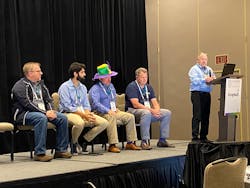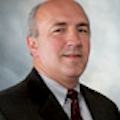Unlocking digital revenue: Innovators share strategies at CSIA 2023 Executive Conference
Just like analog technology, digital tools come in all sorts of shapes and sizes. Tools are designed to make life and work easier or more efficient.
The digital world is still a bit of a new frontier for many, but some people and companies have sallied forth, embracing it and applying what’s available to projects, often creating new business models.
Machine builders are always looking to optimize revenue with available technology, and digital tools have provided newfound inspiration.
At the 2023 Control System Integrators Association (CSIA) Executive Conference in New Orleans, a panel of forward-thinking industry veterans shared their experiences and insights.
Tim Ogden, senior director, partner ecosystem—system integrator business development, GE Digital, led the discussion with Sam Hoff, president and CEO of Patti Engineering, Nigel James, strategic accounts at Triad Control Systems, Renato Leal, founder and CEO, GreyLogix Brasil, and Don Rahrig, founder and CEO of Rain Engineering, regarding how they’re using digital tools to generate revenue.
“In a lot of cases, the customer didn’t prompt them,” Ogden explained. The integrators had to see an opportunity and then find the tools to support what they wanted to do, he noted.
“The sales process needs to start with the problem the client has, not with the solution looking for a problem,” explained Hoff. “It’s very consultative.”
Original equipment manufacturers (OEMs) are requiring the digital twin from suppliers in the automotive industry, said Hoff. “The factory floor is so much more complicated now,” he noted. “It’s not just run on a programmable logic controller (PLC). You don’t need to be a super controls engineer.”
Patti Engineering has been using a lot of digital tools from Siemens for simulation and digital twin, said Hoff. “Simulation is a great tool,” he explained. “You can do virtual commissioning and design with simulation. Once you have that simulation done, you need to get that operational information from the digital twin.”
As an example, Hoff cited his son’s involvement with simulated racing games. “IRacing takes feedback from real cars and brings it back to the simulation,” he explained. Patti Engineering also consults with clients on edge and cloud. “Everyone’s data-crazy,” he noted. “What are data collection considerations when creating digital models? On the edge, it has to be daily data that helps them run better—how production compares to yesterday.”
For diagnostics in a break-fix situation, he recommended concatenating the data on the edge, so everything’s not being sent to the cloud. “How do you get data to the cloud and pull analytics on it?” he asked.
GreyLogix Brasil and its 200-plus employees focus on the process industries. “Digital-industry-as-a-service (DIAS) is a centralized data engineering tool in an object-oriented database,” explained Leal. “From this centralized database, you can have everything from one source. It’s the first steps into the digital twin world—smart piping and instrumentation diagram (P&ID), smart documentation.”
GreyLogix often uses digital tools to help offer various as-a-service models. “We have some services like predictive maintenance and after-sales services,” Leal said.
GreyLogix customers often have common pain points. “The obvious ones can increase efficiency,” he explained. “For me, the most important point is to focus on the risk of not going digital. New technicians can be fluent in digital, but, when they have to go through paper documentation, it’s not such an engaging environment for them to work on. It’s hard to keep people there.”
Digital transformation has become a higher priority in recent years because of issues with the workforce, agreed Rahrig. “It used to be a nice-to-have for our customers,” he said. “Labor was available, but since 2020 the need to digitally transform has changed. There’s a lower cost of technology and simpler-to-connect operational-technology (OT) devices. And it’s harder to find workers and even harder to maintain worker training.”
Integrators like Rain have seen their businesses change because of the available digital technology. “While my business started as a control system integration company, we’re almost solely a manufacturing-execution-system (MES) integrator,” explained Rahrig, who often finds himself and his company focusing on education consulting and integration in the software industry.
“Our education platform is focused on helping people to have a better understanding of MES,” explained Rahrig. “Look for a problem the customer wants to solve, and the sales process will develop for you.”
Most of Rahrig’s problem-solving involves helping customers to understand what they want digital data to do for them.
“When we engage with customers on what data they want to collect, they want all the data,” explained Rahrig. “We’re helping the customer understand there’s only certain data available from the shop floor. We have a survey or assessment we do, and we look at each machine and explain the controllers they have on machines, the connections and the strategies they can use.”
Rain’s recommendation for data use can include status of equipment, performance of equipment, quality, asset health and genealogy—tracking a batch through the process— to name a few.
“People do tons of research on their own online now before they even talk to an integrator,” he noted. “The website had always been a me-too, so a potential customer could look and see that we had a website after a sales call. Instead of selling services to customers because of the labor shortages, it’s more important to build education into products so they’re easier to use.”
In the oil-and-gas or chemical-refinery space, a traditional scope has existed for years. For example, James explained: “The client calls us and tells us there are 500 points. We do a control design, build panels and do a factory acceptance test (FAT). If you have a 500-point system, where do you get the points? It comes from the P&ID and the data sheets.”
Triad Controls Systems is discovering incremental revenue streams with software, noted James. “The value stream and digital transformation can come from digital datasheets using Aveva or smart plant instrumentation (SPI) and digital loop sheets,” he said. “We’ve had to move to consultative selling. With digital datasheets, there’s software that has an instrumentation model where you can do datasheets, cabinet design and wiring diagram.”
A datasheet can take two to four hours per point, explained James. “We use CxAlloy to automate the workflow by using software and databases. You’re showing a service to the client that also saves you time,” he said.
Cybersecurity is one area, however, that James is hesitant to tap for business. “I am a skeptic on the financial revenue side of cybersecurity,” he warned. “It’s important, but from a revenue stream they’ve already defined their policy and bought their software. Focus on the savings because of the software, not the price of the software.”
About the Author
Mike Bacidore
Editor in Chief
Mike Bacidore is chief editor of Control Design and has been an integral part of the Endeavor Business Media editorial team since 2007. Previously, he was editorial director at Hughes Communications and a portfolio manager of the human resources and labor law areas at Wolters Kluwer. Bacidore holds a BA from the University of Illinois and an MBA from Lake Forest Graduate School of Management. He is an award-winning columnist, earning multiple regional and national awards from the American Society of Business Publication Editors. He may be reached at [email protected]

Leaders relevant to this article:

